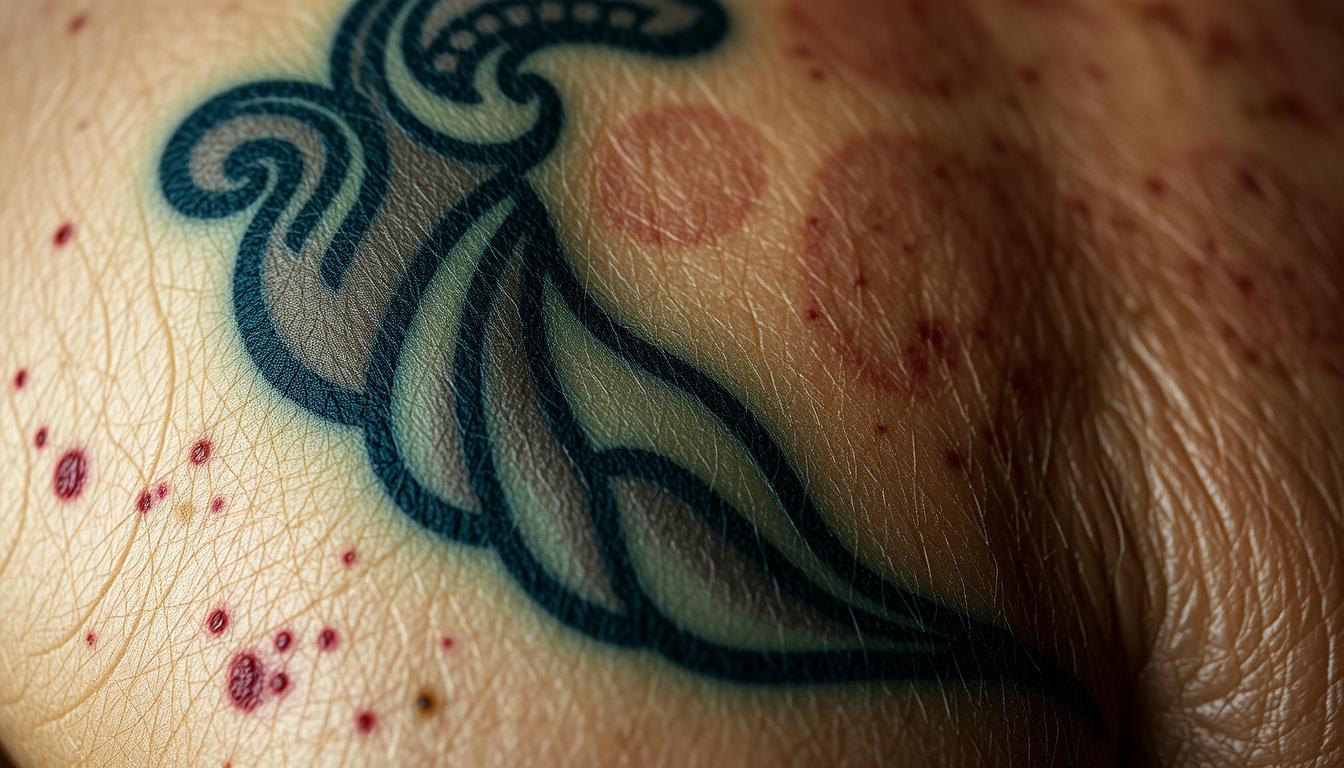
Tattoos are a form of artistic expression that accompany us throughout our lives. Over time, tattoos naturally change appearance, with various signs indicating aging.
As the years pass, tattoo ink can fade, and lines can blur, losing their definition. Modern tattoo inks have evolved significantly since the 80s and 90s, holding up better over the years.
Understanding the aging process of tattoo ink helps in making informed decisions about placement, style, and aftercare, ensuring your tattoo remains vibrant for a long time.
Key Takeaways
- The natural aging process of tattoos affects their appearance over time.
- Factors like sun exposure and skin type influence how quickly a tattoo ages.
- Modern tattoo inks and techniques have improved the longevity of tattoos.
- Proper aftercare is essential for maintaining tattoo vibrancy.
- Understanding the lifecycle of tattoo ink is crucial for long-term satisfaction.
Understanding Tattoo Aging: The Natural Process
The aging process of a tattoo is a complex interplay of the body’s natural processes and external factors like UV exposure. As tattoos age, various changes occur that can affect their appearance.
What Happens to Tattoo Ink Over Time
Over years, tattoo ink undergoes significant changes. The vibrant colors of a fresh tattoo may fade, and the definition between different elements of the design can become less clear. For instance, blacks may take on a bluish or greenish tint.
The Difference Between Fresh and Aged Tattoos
Comparing fresh vs. years-old tattoos reveals significant differences. Fresh tattoos feature crisp lines and vibrant colors, while aged ones may look like they’ve faded or become distorted over time. The contrast between different elements diminishes, making complex designs appear simpler.
| Characteristics | Fresh Tattoos | Aged Tattoos |
|---|---|---|
| Color Vibrancy | Vibrant colors | Faded, muted colors |
| Line Definition | Crisp, clear lines | Less defined, blurred lines |
| Design Complexity | Clear distinction between elements | Elements may merge together |
For those considering tattoo removal or restoration, understanding these changes is crucial.
Common Signs of Aged Tattoos
As tattoos age, they undergo a series of changes that can alter their appearance. Over the years, the initial vibrancy and clarity may give way to various signs of aging.
Fading Colors and Blurring Lines
One of the most noticeable changes is the fading of colors and blurring of lines. The contrast between different elements of the design typically diminishes over time, making intricate tattoos appear simpler or less detailed. Colors can shift in hue over time—reds may take on a more orange or pink tone, blues might shift toward teal, and blacks often develop a bluish cast.
Changes in Tattoo Appearance
Beyond simple fading and blurring, aged tattoos often undergo more complex changes in their overall appearance and relationship to the skin. Some tattoos develop a “patchy” appearance over time, with certain areas retaining ink better than others, creating an uneven look. The edges of tattoo may become less defined, with the boundary between tattooed and non-tattooed skin becoming more gradual rather than sharp.
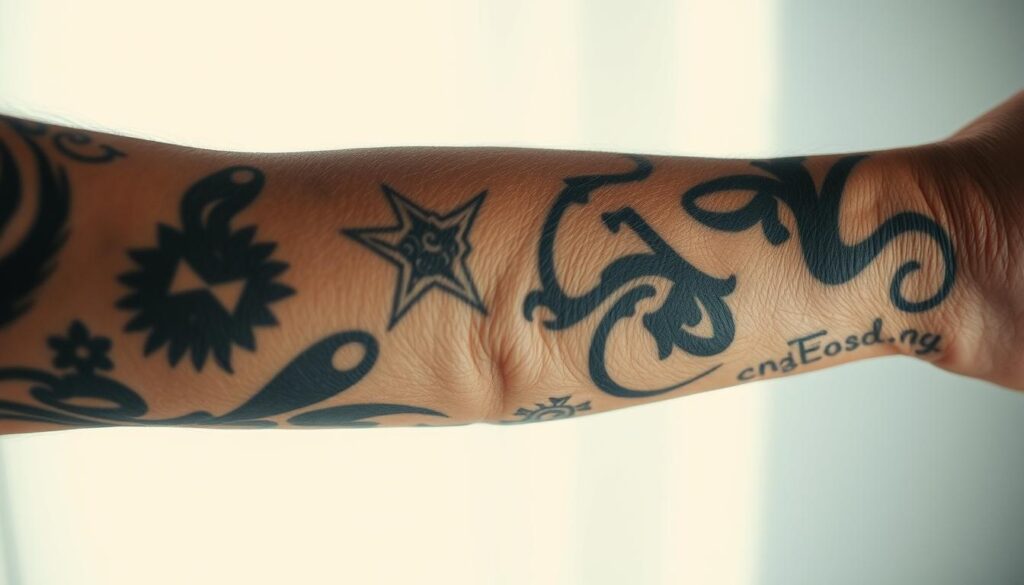
Factors That Accelerate Tattoo Aging
Several factors can accelerate the aging of a tattoo, affecting its appearance over time. Understanding these factors can help in maintaining the tattoo’s quality and longevity.
Sun Exposure and UV Damage
Sun exposure is a significant factor in tattoo aging. UV rays can cause the ink to fade, leading to a loss of color intensity and clarity. Protecting your tattoo from the sun is crucial to maintaining its appearance.
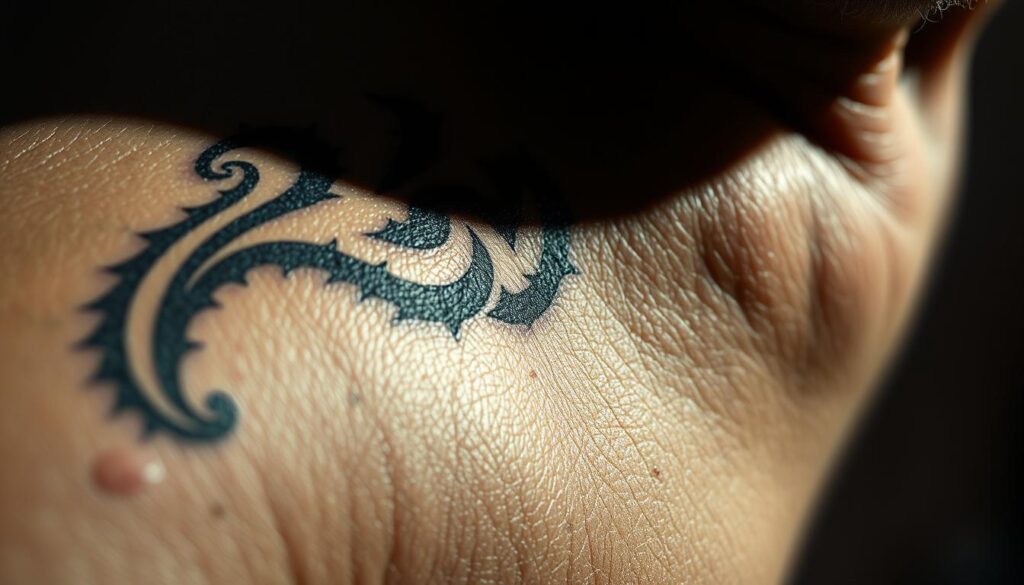
Skin Regeneration and Natural Aging
As we age, our skin undergoes natural regeneration processes. This can affect how a tattoo looks over years. The skin’s natural aging process can cause tattoos to become less vibrant and potentially distorted.
Lifestyle Habits Impact
Lifestyle habits play a crucial role in tattoo aging. Factors such as smoking, hydration levels, and diet can significantly impact the appearance of a tattoo. For instance, smoking can reduce blood flow to the skin, causing tattoos to age more rapidly. A balanced diet and proper hydration, on the other hand, contribute to healthier skin and, consequently, better-looking tattoos. Some habits that affect tattoo aging include:
- Smoking, which constricts blood vessels and reduces oxygen to the skin.
- Poor hydration, leading to dry skin and accelerated ink breakdown.
- Nutritional deficiencies affecting skin health and regeneration.
Maintaining a healthy lifestyle is essential for preserving the quality of your tattoo. You can learn more about the importance of aftercare for tattoos on this page.
| Lifestyle Habit | Impact on Tattoo Aging |
|---|---|
| Smoking | Reduces blood flow, causing faster aging |
| Poor Hydration | Dry skin accelerates ink breakdown |
| Nutritional Deficiencies | Affects skin health and regeneration |
How Different Tattoo Styles Age
The aging process of tattoos varies significantly across different styles. As people get tattoos that reflect their personality or aesthetic preferences, understanding how these styles age is crucial for maintaining their appearance over years.
Traditional vs. Fine Line Tattoos
Traditional tattoos, known for their bold lines and vibrant colors, tend to age differently compared to fine line tattoos. Fine line tattoos, with their delicate and intricate design, may experience more fading and blurring over time due to the finer details. Traditional tattoos, on the other hand, maintain their visual impact longer.
Color vs. Black and Grey Tattoos
The difference in aging between color and black and grey tattoos is notable. Black and grey tattoos generally retain their integrity longer because black ink particles are larger and more stable. Color tattoos, especially those with bright, light colors, tend to fade faster and may require more frequent touch-ups. A comparison of their aging process is shown in the table below.
| Tattoo Style | Aging Characteristics |
|---|---|
| Black and Grey | More stable, retains integrity longer |
| Color | Fades faster, especially bright colors |

As tattoos age over the years, their appearance changes based on their style and the ink used. Understanding these differences helps in maintaining their visual appeal.
The Controversy of Fine Line and Micro-Realism Tattoos
The world of tattoos is witnessing a surge in fine line and micro-realism designs, but their long-term appeal is a topic of heated debate. Many tattoo artists have mixed opinions on the matter, with some believing that with the right design and placement, these tattoos can age well, while others are more skeptical.
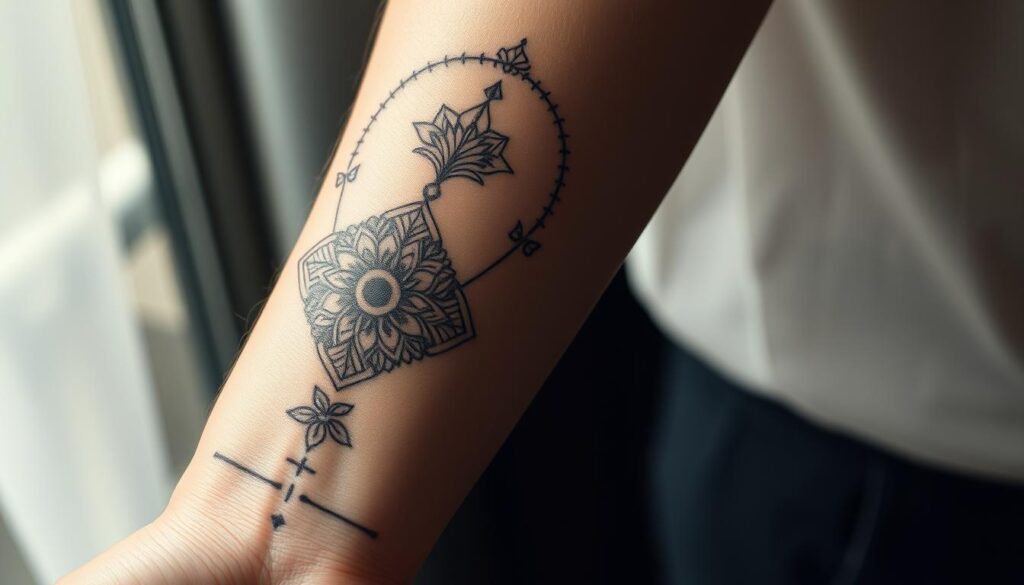
The debate centers around whether the initial aesthetic appeal of these tattoos outweighs the potential disappointment when they inevitably change over the years. As people continue to opt for these styles, understanding their longevity becomes crucial.
Why These Styles May Not Age Well
Experienced artists express concern about clients choosing minimalist and fine line tattoos without understanding their aging process. These tattoos may not hold up well over time, particularly if they involve very small text or intricate details.
Expert Opinions on Minimalist Tattoos
Some artists recommend compromises, such as slightly thicker lines or simpler designs, to improve longevity. Others suggest regular touch-ups to maintain the appearance, though this requires ongoing commitment. Most agree that educating clients about tattoo aging is essential, especially for those interested in fine line and minimalist styles, to manage expectations over the years.
Tattoo Placement and Aging
The placement of a tattoo significantly influences its aging process, with certain areas of the body proving more conducive to maintaining the design’s integrity over the years. The longevity of a tattoo is affected by various factors including friction, sun exposure, and skin regeneration.
High-Friction Areas: Hands, Feet, and Joints
Areas like the hands, feet, and joints are considered high-friction and tend to experience more wear and tear, potentially affecting the tattoo design. These areas are prone to constant movement and friction, which can cause the ink to spread or blur over time.
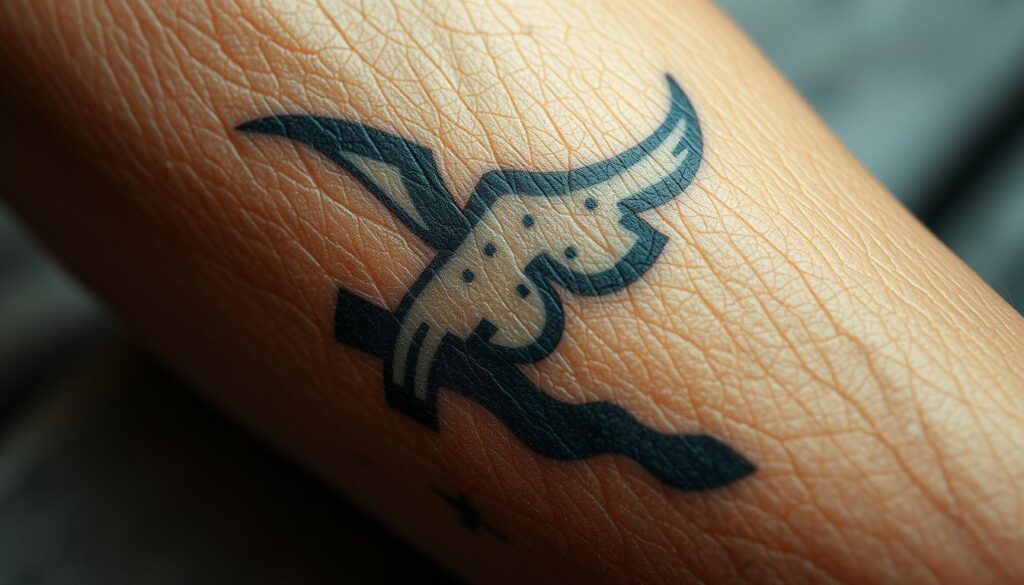
Best Placement for Long-Lasting Tattoos
For a tattoo to age well, it’s essential to choose a placement that minimizes exposure to harmful factors. Areas like the upper outer arm, shoulder, upper back, and chest are considered ideal due to their relatively stable skin and limited sun exposure.
| Body Area | Tattoo Longevity | Reasons |
|---|---|---|
| Upper Outer Arm/Shoulder | Excellent | Limited sun exposure, minimal friction |
| Upper Back/Chest | Excellent | Protected by clothing, minimal stretching |
| Inner Forearm | Good | Less sun exposure than outer forearm |
| Thigh (Outer) | Good | Thicker skin, protected by clothing |
Choosing the right placement for a tattoo can significantly impact its appearance over years. By considering factors like skin thickness and design requirements, individuals can help ensure their tattoo remains vibrant for a longer period.
Evolution of Tattoo Inks Since the 80s-90s
The evolution of tattoo inks since the 80s and 90s has been remarkable, with modern inks offering better durability. Over the years, the quality and composition of tattoo ink have undergone significant changes.
Old vs. Modern Ink Compositions
In the 80s and 90s, tattoo inks were more prone to fading due to UV exposure and skin aging. Black tattoos often turned blue or green over time, and colors faded unevenly. In contrast, modern inks are more refined, offering better saturation and longevity.
How Improved Inks Affect Longevity
Modern tattoo inks have several advantages that affect the longevity of tattoos. These include finer particle sizes, improved UV resistance, and purer pigments, which reduce the risk of inflammatory reactions. As a result, tattoos done with quality modern inks maintain their appearance significantly longer than those done with older inks.
| Characteristics | 80s-90s Inks | Modern Inks |
|---|---|---|
| Particle Size | Larger, inconsistent | Finer, consistent |
| UV Resistance | Poor, prone to fading | Improved, resistant to yellowing |
| Pigment Purity | Lower purity, more reactions | Higher purity, fewer reactions |

Advancements in Tattooing Techniques
The tattoo industry has seen significant advancements in techniques over the years, enhancing the quality and durability of tattoos. Modern tattooing techniques have evolved to address the challenges of aging, ensuring that tattoos remain vibrant and intact for longer periods.
Equipment Changes Over the Decades
In the past, tattoo equipment and hygiene standards were not as rigorous as they are today. Sterilization practices were less regulated in the 80s-90s, leading to inconsistent ink quality and higher risks of infections. Since the 2000s, hygiene standards have significantly improved with the use of single-use equipment and mandatory sterile gloves. Inks now comply with strict EU and US regulations, including screening for carcinogens and allergens.
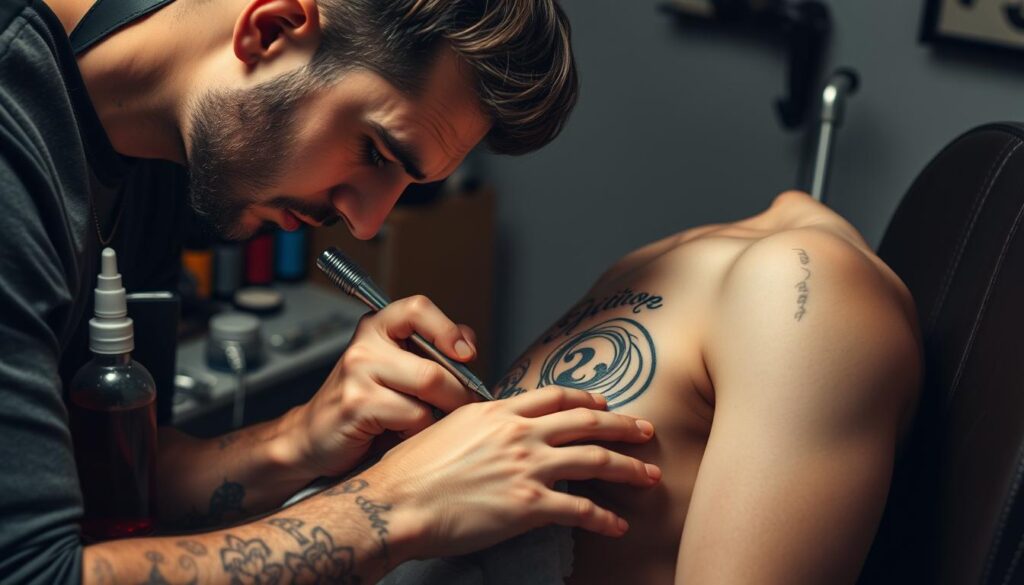
How Modern Techniques Improve Tattoo Durability
Modern tattooing techniques emphasize proper depth control, placing ink in the optimal layer of dermis for longevity without causing scarring or blowouts. Artists now have a better understanding of skin anatomy, and application methods have been improved to reduce trauma to the skin, resulting in faster healing and better initial ink retention. Techniques such as layering and shading have become more sophisticated, creating smoother gradients that age more gracefully.
| Technique | Improvement |
|---|---|
| Depth Control | Optimal ink placement for longevity |
| Layering and Shading | Smoother gradients that age well |
| Application Methods | Reduced trauma, faster healing |
These advancements in tattooing techniques have significantly improved the durability and appearance of tattoos over the years, ensuring that they remain a vibrant form of self-expression.
Preventative Care for Aged Tattoos
Tattoo aftercare is crucial for maintaining the vibrancy and integrity of your ink over the years. Proper care can significantly impact how well your tattoo ages.
Daily Skincare Routine for Tattooed Skin
Establishing a daily skincare routine is vital for tattooed skin. Use a gentle cleanser and moisturizer to keep the skin hydrated. Keeping your skin moisturized helps maintain the tattoo’s appearance.
- Cleanse the tattooed area gently
- Apply a moisturizer to keep the skin hydrated
Sun Protection Strategies
Protecting your tattoo from the sun is crucial. UV rays can cause significant fading. Use a broad-spectrum sunscreen with SPF 30-50 on exposed tattoos. Reapply every two hours during sun exposure.
| Sun Protection Method | Effectiveness |
|---|---|
| Broad-spectrum sunscreen (SPF 30-50) | High |
| UPF-rated clothing | Very High |
| Avoiding peak sun hours (10am-4pm) | High |
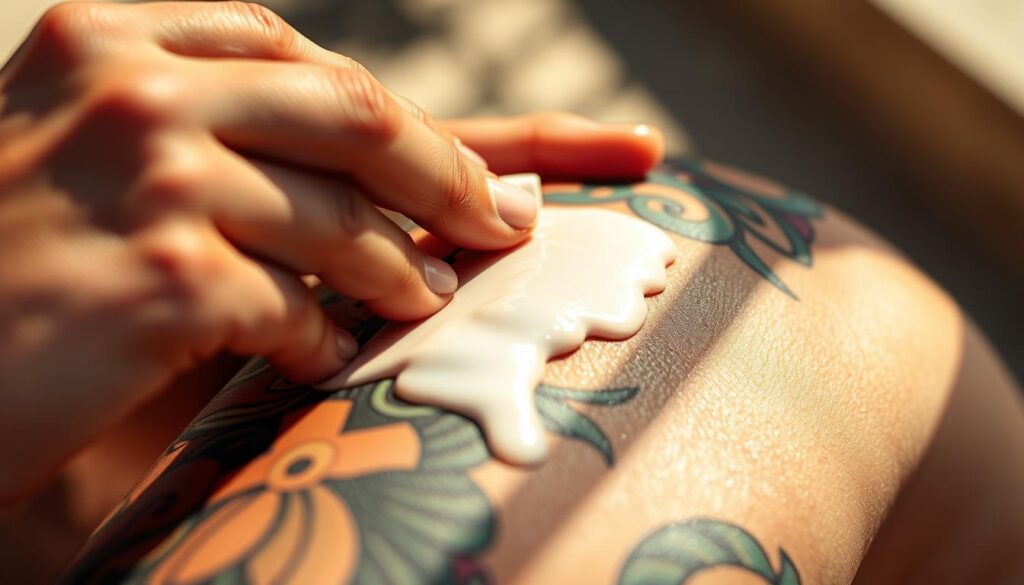
Weight Fluctuations and Tattoo Appearance
Weight gain or loss can alter the look of tattoos on the skin. As the body changes, the skin stretches or shrinks, affecting the tattoo’s design and clarity.
How Weight Gain Affects Tattoos
When you gain weight, your skin expands, which can cause tattoos to become distorted. The extent of the distortion depends on the amount of weight gained and the area of the body affected. For instance, significant weight gain can lead to stretch marks, which may interrupt the tattoo design.
Weight Loss Impact on Tattoo Integrity
Losing weight after having a tattoo can also impact its appearance. Significant weight loss may result in loose or saggy skin, potentially causing tattoos to wrinkle or fold. The degree of skin elasticity recovery varies based on age, genetics, and the rate of weight loss.
| Weight Change | Effect on Tattoo |
|---|---|
| Weight Gain | Distortion, potential stretch marks |
| Weight Loss | Saggy skin, wrinkling, or folding |
For more information on how life changes can affect tattoos, you can visit this page to learn about getting tattoos during significant life events like pregnancy.
Timeline of Tattoo Aging: What to Expect
The journey of a tattoo from its fresh state to an aged one is a story of gradual change. As years pass, various factors influence how a tattoo looks.
First Year Changes
In the first year, a tattoo undergoes significant changes, including fading and settling of the ink. The initial vibrant colors may dull, and the lines may become less sharp.
5-10 Year Marks
Between 5-10 years, the tattoo continues to age, with colors potentially fading further. The skin’s natural regeneration process and exposure to the sun play crucial roles in how the tattoo looks during this period.
Decades-Old Tattoos
Tattoos that are decades old often develop a unique, vintage appearance. The ink may spread slightly, and the colors can change, but well-designed tattoos with strong outlines tend to remain recognizable.
| Timeframe | Changes Observed |
|---|---|
| First Year | Fading, ink settling |
| 5-10 Years | Further fading, color changes |
| Decades | Vintage appearance, ink spread |
Treatment Options for Reviving Aged Tattoos
Aged tattoos can be rejuvenated through a range of treatments that address fading and blurring. Over time, tattoos can lose their original vibrancy due to various factors, including sun exposure and natural aging processes.
Touch-Ups and Color Revitalization
Touch-ups are a common method for restoring the clarity of aged tattoos. For tattoos that have faded significantly, color revitalization can revive the original design. This involves reapplying pigments to restore dull tones or adjusting the color palette for a fresher look. Techniques such as adding highlights and contrasts can also enhance the overall appearance, making the tattoo look more dynamic.
Reworking and Recoloring Techniques
Reworking goes beyond simple touch-ups, involving the modification or enhancement of the original tattoo design. This approach can modernize outdated styles or improve poorly executed work while maintaining the core concept. Artists can add depth and dimension to flat, faded designs through techniques like highlighting, shading, and creating contrast. For tribal or solid black tattoos that have blurred, artists can redefine edges and add internal detailing for a more refined appearance.
Non-Invasive Methods to Enhance Aged Tattoos
With time, tattoos can fade, but non-invasive techniques offer a solution to enhance their longevity and visual appeal. As tattoos age, they can lose their vibrancy due to various factors including sun exposure and skin regeneration.
Intensive Hydration and Skincare Products
Using intensive hydration and skincare products can significantly improve the appearance of aged tattoos. Professional-grade skincare treatments containing ingredients like retinol and vitamin C can improve overall skin quality.
Aesthetic Care Techniques
Several aesthetic care techniques can enhance aged tattoos. These include:
- Professional microdermabrasion treatments to remove dead skin cells.
- Light chemical peels to improve skin texture and clarity.
- Microneedling around tattoos to stimulate collagen production.
Afteryearsof having a tattoo, these methods can help restore its original beauty.
These non-invasive methods can be effective for people looking to revitalize their aged tattoos without undergoing major touch-ups.
When to Consider a Cover-Up vs. Restoration
Deciding whether to restore or cover an aged tattoo is a crucial step in its maintenance. As tattoos age, their appearance can significantly change, prompting a reevaluation of their condition.
Assessing Your Aged Tattoo’s Condition
To determine whether your tattoo needs restoration or a cover-up, assess its current state. Consider factors like fading, blurring, and any damage. If the tattoo still holds its original charm but has minor flaws, restoration might be the best option.
Consulting with a Professional Artist
Consulting with a professional artist is essential. They can provide objective advice based on their experience with both restoration and cover-ups. Bringing photos of the tattoo when it was fresh can help the artist understand what’s been lost and what might be recoverable. This consultation should include a discussion of the potential outcomes and limitations, ensuring a realistic understanding of what can be achieved over the years.
Celebrity Tattoos: How They’ve Aged Over Time
The world of celebrity tattoos offers a fascinating glimpse into how different tattoo styles age over years. Celebrities, with their public lives and documented tattoos, provide valuable case studies on the aging process of tattoos.
Famous Examples of Well-Aged Tattoos
Some celebrity tattoos have aged remarkably well, maintaining their original vibrancy and detail. For instance, people often cite Johnny Depp’s tattoos as examples of well-aged ink. These examples highlight the importance of working with skilled tattoo artists and proper aftercare.
Lessons from Celebrity Tattoo Transformations
The transformations of tattoos on celebrities over the years offer several lessons for people considering tattoos. These include the impact of weight fluctuations, sun exposure, and the quality of the tattoo ink used. By examining these transformations, individuals can make more informed decisions about their own tattoos.
Conclusion: Embracing the Journey of Your Aging Ink
Tattoos are not just art on your skin; they are a part of your personal history that evolves over time. As you’ve learned, the aging process of your tattoos is influenced by various factors, including sun exposure, skin regeneration, and lifestyle habits.
With proper care, such as regular skincare and sun protection, you can significantly extend the life of your tattoo. If your ink has faded over the years, consider consulting a professional for touch-ups or restoration. Embracing the changes in your tattoos can lead to a deeper appreciation of their significance and the story they tell about your journey through life.
